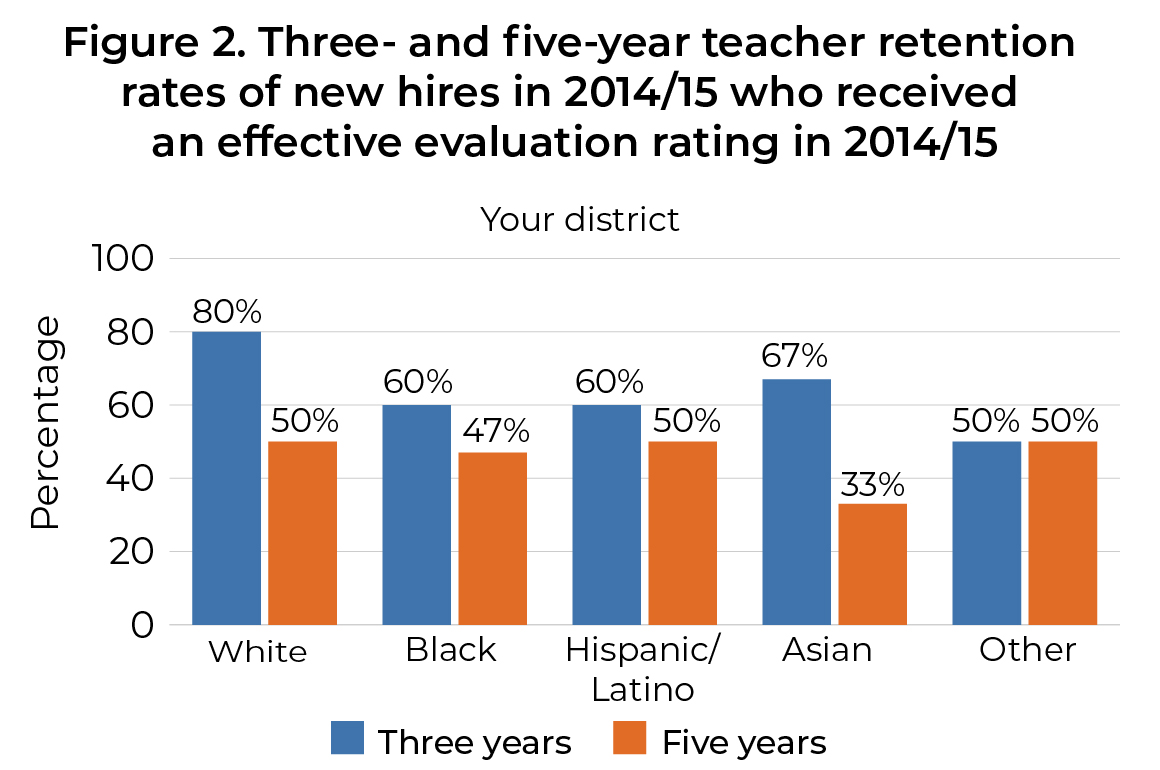
A recent Education Week article underscored how the COVID-19 pandemic has exacerbated the longstanding need to improve the diversity of the teacher workforce.
Expanding the diversity of teachers is one route to improving the educational outcomes of students of color and reducing disparities in achievement. Studies have documented that students, especially Black students, taught by a teacher of the same race generally score higher on math and reading tests and have better educational outcomes:
- Black students in kindergarten to grade 3 taught by a Black teacher had math scores 2 to 5 percentile points higher and reading scores 3 to 6 percentile points higher than Black students in those grades taught by a White teacher (Dee, 2004).
- Black students who have at least one Black teacher are about 5 percentage points more likely to graduate high school and about 4 percentage points more likely to enroll in college than their peers who are not assigned to a Black teacher (Gershenson et al., 2018).
- Being taught by a teacher of the same race or ethnicity lowers a student’s suspension and expulsion rates (Holt & Gershenson, 2015, Lindsay & Hart, 2017). In particular, non-White kindergarten to grade 5 students taught by teachers of the same race or ethnicity had 19 percent fewer suspensions per year (Holt & Gershenson, 2015).
Nationwide, most students of color are not taught by teachers of their race or ethnicity. The proportion of students who are Black or Hispanic is two to three times larger than the proportion of teachers who are Black or Hispanic, and that the gap appears to be increasing (Hansen & Quintero, 2019). During the next decade, the proportion of White students will continue to decline, the proportion of Black students will stay about the same, and the proportion of Hispanic students will increase. Yet data from 2000 to 2016 suggest that teacher demographics are changing more slowly, with substantial room for improvement in diversifying the workforce.

Note: The percentages apply to public elementary and secondary schools.
Sources: National Center for Education Statistics. (n.d.). Digest of Education Statistics.
REL Mid-Atlantic created an automated tool to help state education agency staff support their districts in identifying gaps in the diversity of their teacher workforces. REL Mid-Atlantic’s Automated Teacher Diversity District Tool generates reports showing the racial and ethnic makeup of each district’s student and teacher populations and their teacher retention rates by race and ethnicity. Figures 1 and 2 show examples of the figures contained in the reports. The automated tool can also generate retention rates specifically for teachers with effective evaluation ratings who might have more ability to improve student outcomes and could be especially important for districts to retain.


Users just plug in the required data, and the tool will automatically generate a profile for each district of interest.[1] The time involved depends on the availability of the data but can range from as little as 30 minutes to more than an hour. Generating the profiles takes about one to two minutes for every five districts. States might also find the Automated Teacher Diversity District Tool a useful resource for better understanding the racial and ethnic makeup of their students and teachers and for making progress on the path to greater teacher diversity.
References
Dee, T. S. (2004). Teachers, race, and student achievement in a randomized experiment. Review of Economics and Statistics, 86(1), 195–210. https://www.mitpressjournals.org/doi/pdf/10.1162/003465304323023750
Egalite, A. J., Kisida, B., & Winters, M. A. (2015). Representation in the classroom: The effect of own-race teachers on student achievement (Working Paper No. PEPG 14-07). Harvard Kennedy School, Program on Education Policy and Governance. https://files.eric.ed.gov/fulltext/ED562618.pdf
Gershenson, S., Hart, C., Hyman, J., Lindsay, C., & Papageorge, N. W. (2018). The long-run impacts of same-race teachers (NBER Working Paper No. w25254). National Bureau of Economic Research. https://www.nber.org/papers/w25254.pdf
Hansen, M., & Quintero, D. (2019). The diversity gap for public school teachers is actually growing across generations. Brown Center on Education Policy. https://www.brookings.edu/blog/brown-center-chalkboard/2019/03/07/the-diversity-gap-for-public-school-teachers-is-actually-growing-across-generations/
Holt, S., & Gershenson, S. (2015). The impact of teacher demographic representation on student attendance and suspensions (IZA Discussion Paper No. 9554). Institute for the Study of Labor. http://ftp.iza.org/dp9554.pdf
Lindsay, C. A., & Hart, C. M. (2017). Exposure to same-race teachers and student disciplinary outcomes for Black students in North Carolina. Educational Evaluation and Policy Analysis, 39(3), 485–510. https://journals.sagepub.com/doi/pdf/10.3102/0162373717693109
National Center for Education Statistics. (n.d.).
U.S. Department of Education. (2016). The state of racial diversity in the educator workforce. https://www2.ed.gov/rschstat/eval/highered/racial-diversity/state-racial-diversity-workforce.pdf
Footnotes
[1]The data must be in a format that can be copied and pasted into the tool’s Excel file. See the tool’s Excel file and instructions document for more details.
Cross-posted from the REL Mid-Atlantic website.


